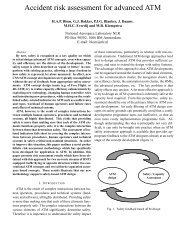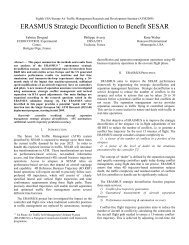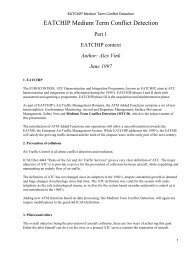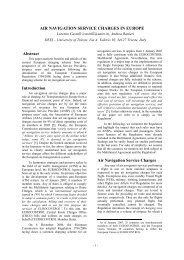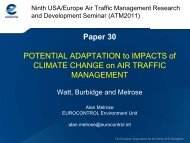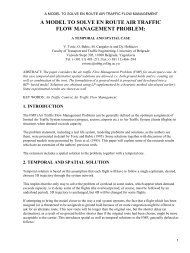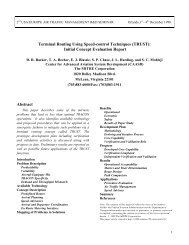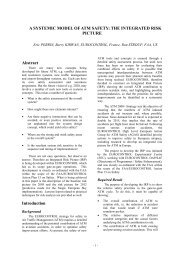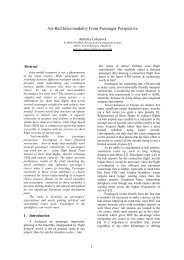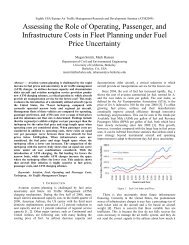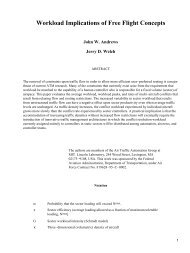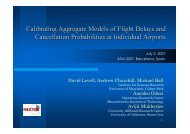preliminary evaluation of flight delay propagation ... - ATM Seminar
preliminary evaluation of flight delay propagation ... - ATM Seminar
preliminary evaluation of flight delay propagation ... - ATM Seminar
You also want an ePaper? Increase the reach of your titles
YUMPU automatically turns print PDFs into web optimized ePapers that Google loves.
AbstractAirline <strong>flight</strong> schedules are particularly sensitive toindividual <strong>flight</strong> <strong>delay</strong>s because <strong>of</strong> the manner inwhich operating resources are linked together.Among the connective resources affected by <strong>delay</strong>ed<strong>flight</strong> operations are crews, aircraft. passengers andgate space. Because <strong>of</strong> this branching connectivitythe <strong>delay</strong> <strong>of</strong> one <strong>flight</strong>s tends to propagate rapidlydown line to many others. In order to evaluate aninitial <strong>flight</strong> <strong>delay</strong> on an airline operating schedulethis paper proposes the concept <strong>of</strong> a Delay Multiplier(DM).Using American Airlines crew and aircraftconnectivity through an actual airline operatingschedule the DM demonstrates the value <strong>of</strong> <strong>delay</strong> (or<strong>delay</strong> reduction) on the operating schedule as awhole. The relationship between the duration <strong>of</strong>initial <strong>delay</strong>, the time <strong>of</strong> day <strong>of</strong> the <strong>delay</strong>occurrences and airline schedule connectivity areused to calculate the value <strong>of</strong> the DM.Specifically, this process was developed to evaluatechanges in the FAA's Air Traffic ManagementGround Delay Program procedures.Background1. The ProblemWhen the <strong>flight</strong> arrival demand exceeds an airport'sacceptance capacity, it is the job <strong>of</strong> the FAA's AirTraffic Control System Command Center(ATCSCC) to control demand. This is <strong>of</strong>ten donethrough the use <strong>of</strong> a technique called the GroundDelay Program (GDP). Under this programATCSCC issues Controlled Times <strong>of</strong> Arrival (CTAs)to <strong>flight</strong>s still on the ground but destined to arrive atthe constrained airport to ensure the airport capacityis not exceeded. GDP can produce <strong>delay</strong>s forindividual <strong>flight</strong>s ranging from a few minutes toseveral hours. These <strong>delay</strong>s are <strong>of</strong> concern to anyuser, but are most disruptive to airline operatorswhose schedules are made up <strong>of</strong> tightly connectedoperating resources (i.e. aircraft and crews).Intuitively, large <strong>delay</strong>s early in the operating dayare most disruptive, while short <strong>delay</strong>s (or <strong>delay</strong>s latein the day) have little or no <strong>propagation</strong> through theschedule.To better understand the total effect <strong>of</strong> airline <strong>flight</strong><strong>delay</strong>s produced by ATCSCC GDPs, AmericanAirlines and Oak Ridge National Laboratorycollaborated on a joint study to see if a numerical"<strong>delay</strong> multiplier" (DM) could be derived that wasbased on the length <strong>of</strong> the initial <strong>delay</strong> and the time<strong>of</strong> day it occurred.This was not an attempt to predict the actualdownline effect any given <strong>flight</strong> <strong>delay</strong> wouldproduce, but rather to develop a "generic" total value<strong>of</strong> both the initial <strong>delay</strong> and its continuingconsequences on the airline schedule. This totalvalue could then be used in the <strong>evaluation</strong> <strong>of</strong> changesin GDP procedures.It seemed obvious to those that operate airlineschedules that reducing a 60 minute <strong>delay</strong> to 30minutes is much more valuable than reducing a 30minute <strong>delay</strong> to zero. The question is: How does thevalue <strong>of</strong> initial <strong>delay</strong> reduction vary based on boththe length <strong>of</strong> the initial <strong>delay</strong> and the time <strong>of</strong> day atwhich it occurs?It is important to note that, for an airline, the "value"<strong>of</strong> <strong>delay</strong> is not just its effect on an individualairframe but its effect on the operating schedule. Itis this schedule that is the primary product <strong>of</strong>feredto the traveling public. Passengers do not go out tothe airport to fly on a specific airplane or with aspecific crew. They go to catch the two o'clock<strong>flight</strong> to Chicago which is promised in the airline'spublished schedule. A significant part <strong>of</strong> the airline'sday-to-day operational effort is expended in theattempt to keep that promise.2. The Concept <strong>of</strong> Delay Multiplier (DM)To establish the value <strong>of</strong> the DM we decided toanalyze the conductivity <strong>of</strong> crew sequences andaircraft sequences though the American Airlines<strong>flight</strong> schedule. While these are the obvious andprimary assets needed to operate <strong>flight</strong>s, there areother resources that are affected by <strong>delay</strong>ed <strong>flight</strong>operations that were not considered due to theircomplexity. Most notably, the affect <strong>of</strong> <strong>delay</strong>edoperations on passengers, cargo and gate space werenot considered. Each <strong>of</strong> these can induce <strong>delay</strong>s inother <strong>flight</strong>s. Therefore we believe our calculatedDMs based on crew and aircraft only to be highlyconservative.The concept <strong>of</strong> Delay Multiplier can be consideredas that value, which when multiplied by the initial<strong>delay</strong>, would yield all <strong>of</strong> the potential downline2



